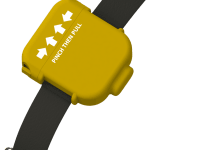
Epinephrine auto-injectors on the market are too large to carry comfortably. For this reason, 60% of auto-injector users do not regularly carry their devices. LifeWatch is the first wrist-worn epinephrine auto-injector for the 1 in 50 Americans with anaphylactic allergies. Our device performs the same functions as other auto-injectors but takes up much less space: a 53% reduction in volume compared to the EpiPen and a 41% reduction compared to the Auvi-Q, the two leading products on the market. By minimizing the outer dimensions of the device, LifeWatch can be comfortably worn like a watch in a way that other auto-injectors cannot. This means that users can easily take it wherever they go.
The device’s small size and simple mechanisms make it easy to manufacture and assemble. Initial cost analysis has led to a cost estimate of $9.30 for each device when produced at high volume, which is significantly lower than the cost of current options on the market. Most components in the device could be injection molded, along with a few simple machined parts. There exist numerous manufacturers that could create this device.
If a user is undergoing an anaphylactic reaction and needs to administer an injection of epinephrine, the first thing they do is pull off LifeWatch’s back safety cap. Then, they remove the injection cartridge, which is rectangular in shape and has a large activation button protruding from the front. The user pushes the device against their outer thigh such that the activation button is in contact with their leg.
When this happens, the activation button is pushed into the body of the cartridge. This motion bends two internal flexures away from the center of the device. The syringe and needle, which had been resting on the flexures, become unconstrained and are pushed by two springs. These springs drive the needle out of the device and into the user’s thigh. The motion of the syringe triggers a quick release system and unconstrains the motion of the syringe plunger. A different pair of springs then push on the plunger and force the medicine out of the syringe through the needle. After injection is complete, the user can rotate a needle cover over the exposed sharp to prevent injury.
LifeWatch is poised to revolutionize a large and growing industry. EpiPen, the leading device on the market, generates over $1 billion in sales annually, and the number of auto-injectors prescribed annually is increasing. Additionally, users are in desperate need for a novel device; consumer research shows that a watch profile would be significantly more popular than the options currently on the market. With LifeWatch, patients and their families would no longer have to constantly worry about having an auto-injector nearby in case of an emergency, and those who do need it would be better prepared. LifeWatch is the solution to a problem that the anaphylactic community truly deserves, and we hope that it will save lives every single day.
Video
-
Awards
-
 2018 Top 100 Entries
2018 Top 100 Entries
Like this entry?
-
About the Entrant
- Name:Benjamin Bernstein
- Type of entry:teamTeam members:Ben Bernstein
Reed Ginsberg
Daniel Orol - Software used for this entry:SolidWorks, COMSOL, MATLAB
- Patent status:pending








